A blog about preserving thousands of audiovisual materials in media formats dating from 1916 to today. Let our collections help you tell your stories.
Don't wanna be here? Send us removal request.
Text
America's First Drive-In Church
It's time for another posting about one of our favorite a/v collections, that of the Protestant Radio & Television Center (1940s-1990s). The center was created by several Protestant denominations and organizations around the southeast and, in 1949, borrowed space at Agnes Scott College to begin radio productions. In 1955, their own $300,000 building near Emory University was opened and radio, television, and film productions were made there. They had many years of fruitful work and high quality productions, but by the 1990s, things had changed and PRTVC shut down, though their radio ministry is carried on by Day One Media in Atlanta.
In the early 2000s, their productions archive--film elements and prints, audiotapes--was donated to us so their building could be torn down. As we have processed it, some wonderful productions have come to light, including film of the groundbreaking for that building. You can watch those we've digitized to date here: https://bmac.libs.uga.edu/Search/objects/key/4f6f30fbdea84389cd80fccf9f4b338b/facet/has_media_facet/id/1/view/list
Back in 1957, PRTVC's film crew spent some time in sunny Florida to produce the first program for their "Trail Blazers" TV series. This episode was about how Whitfield Estates Presbyterian Church in Sarasota--America's First Drive-In Church--came to be.




Sadly for us, we do not have a complete set of production elements for this show, nor do we have a finished sound print of it. But the outs and trims--in stunning Kodachrome, looking as fabulous as the sunny days they were shot--survive and we preserve them here. Though there hasn't been time to splice these together and show them moving, we want to share some stills.
PRTVC's Towers newsletter from December 1957 mentions the series in production (see a frame grab from this shot below).

Thanks to Florida's Manatee Public Library, you can read online a scanned document explaining the history of this drive-in church, as told by Dorothy Walker in 1981. She mentions that this show aired on over 50 tv stations around the country, as well as that many newspapers picked up the story of this unusual church, and even Time and Newsweek mentioned it.
The film tells the story of Dr. Lowry Bowman in Sarasota, Florida, who had been pastor of the First Presbyterian Church since 1928.

Dr. Bowman wanted to assist his parishioners who had mobility issues. ADA laws were a long way into the future at that point, so wheelchair access was probably difficult. He may also have wanted to bring in some of the tourists milling about that area...



It is said that seeing a drive-in theater inspired him, but I also like to think that lunching at drive-in hot dog or burger stand helped his thoughts along, too--

What if he could create a drive-in church? People wouldn't have to get out of their cars to get into a church building that wasn't handicapped accessible. They could come as they are, perhaps on the way to someplace else, but stop at the drive-in for services. The novelty alone would bring in the curious tourists, and perhaps they'd make church a regular stop on their vacations.
So he made arrangements with the owner of the Trail Drive-In Theater to start holding services there until he can get his own church built. The first service was held Sunday morning, January 4, 1953 and they did actually list the event as "The Devil Takes a Holiday."




Dr. Bowman stood on the bed of a truck and preached through a microphone to the speakers in about 200 cars. An organ, pulpit, and sound equipment were later housed in a small building where the minister eventually stood on the roof deck to preach.
The church eventually bought property of their own from the Edith Ringling estate...

to erect a church building where they could also house cars to continue the drive-in aspect of their church. This postcard image shows the new building, with a similar shot in the film just below it.


And here's the automotive congregation behind the building--

and some views of the parishioners. They even received communion "wine" at their car windows.






That last image is of one of the parishioners who Rev. Bowman had in mind when he built the church.
Dr. Bowman died in 1964, but he put this church and its option to stay in your car to worship into the zeitgeist. His son, B.L. Bowman, Jr., graduated from our own University of Georgia and became a journalist.
This article describes some other drive-in churches in Florida.
Google Maps shows the Whitfield church's location and the shape of the building:

And Street View shows the building still standing in May 2011, with its distinctive tall windows peeking through the trees:

But by November 2022, it had been torn down and nothing appears to have been built in its place since then:

Looks like the congregation moved on in 2019:


During the Covid-19 pandemic of 2020, the trend came back, this time in Georgia:

R.I.P., drive-in church! What a fun idea and we are thrilled to preserve some of its history here at the Brown Media Archives!
3 notes
·
View notes
Text
Actor Victor Jory for Delta Airlines
Those of you who've seen GONE WITH THE WIND will recall Victor Jory playing the cruel overseer. Of course, beyond that one part, he was a very talented actor with a long and varied career on stage and screen (he was even in an episode of KOLCHAK: THE NIGHT STALKER!) but I'll bet you didn't know he did a job for Delta Airlines in 1963. I didn't, until we started inventorying the Protestant Radio & Television Center material here at the archives. The filmmakers at PRTVC mostly created religious radio broadcasts and films, but they took on some commercial work as well. Clearly, they worked with Delta Airlines, one of the biggest corporations headquartered in Atlanta.
In this reel of outtakes, Jory appears to tell us a story about how fabulous Delta is. He either plays himself or a generic businessman, needing to fly somewhere for work. And he wants to tell us how the trip went, from his office, and using a film.

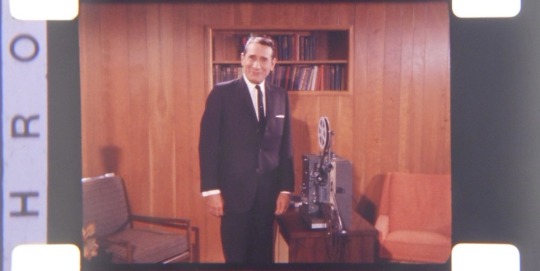
First, look at all the U.S. locations Delta flies in 1963! (so many!)
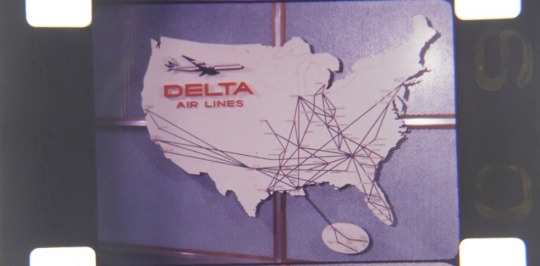
At the airport, he encounters the friendly ticket agent,
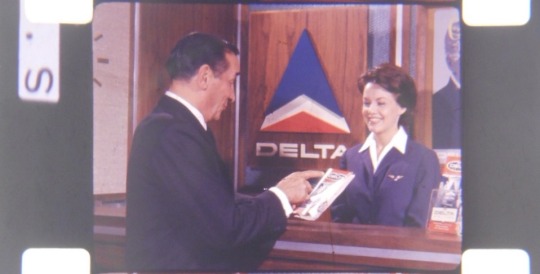
pockets his ticket
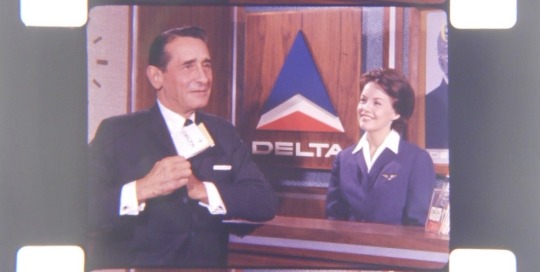
gets his seat (look how large the seats are!), probably in first class:
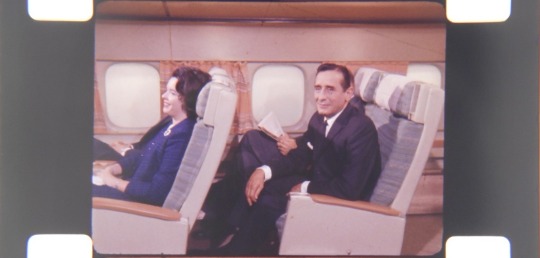
and then gets served a huge meal with champagne being poured!
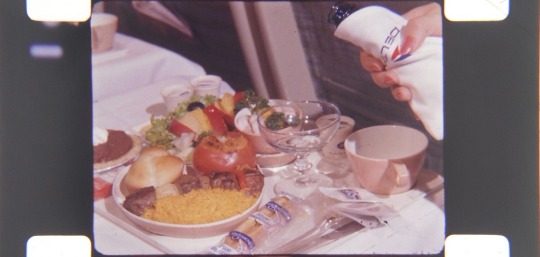
I see steak (I think), corn, a stuffed tomato, a dinner roll, a salad, breadsticks, and chocolate pudding for dessert:
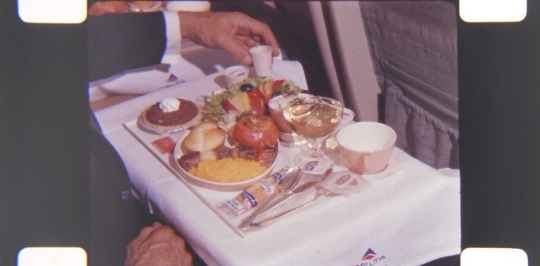
And after the flight, he picks up his own luggage. A humble actor, no personal assistant here.
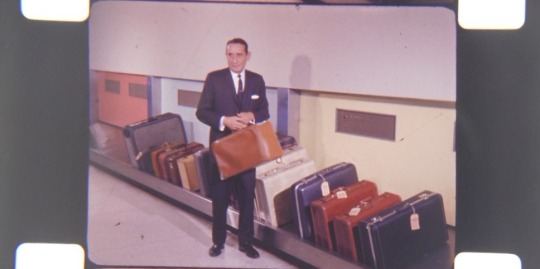
I don't know how the story ends, but I'll bet Jory had a great time doing this job, earned a great paycheck, and I'll bet his flight from L.A. to Atlanta was free and he probably did get champagne. We're pleased the material has survived, the Ektachrome color is still so fabulous, and we can share it with you.
6 notes
·
View notes
Photo

Indeed, this film titled THE CRUCIFIXION did likely belong to the Protestant Radio & Television Center, which created and circulated religious films, and in whose collection we discovered this reel and note. The Atlanta Film Library was part of the State Department of Education, and many of our once-circulating educational films have their label on the reel.
The Digital Library of Georgia has scanned a 1959-60 catalog of films offered by the GA Dept. of Ed and it is available here: https://dlg.usg.edu/record/dlg_ggpd_y-ga-be300-pi5-bs1-bc2-bno-p-b6-bsuppl-p

18 notes
·
View notes
Photo

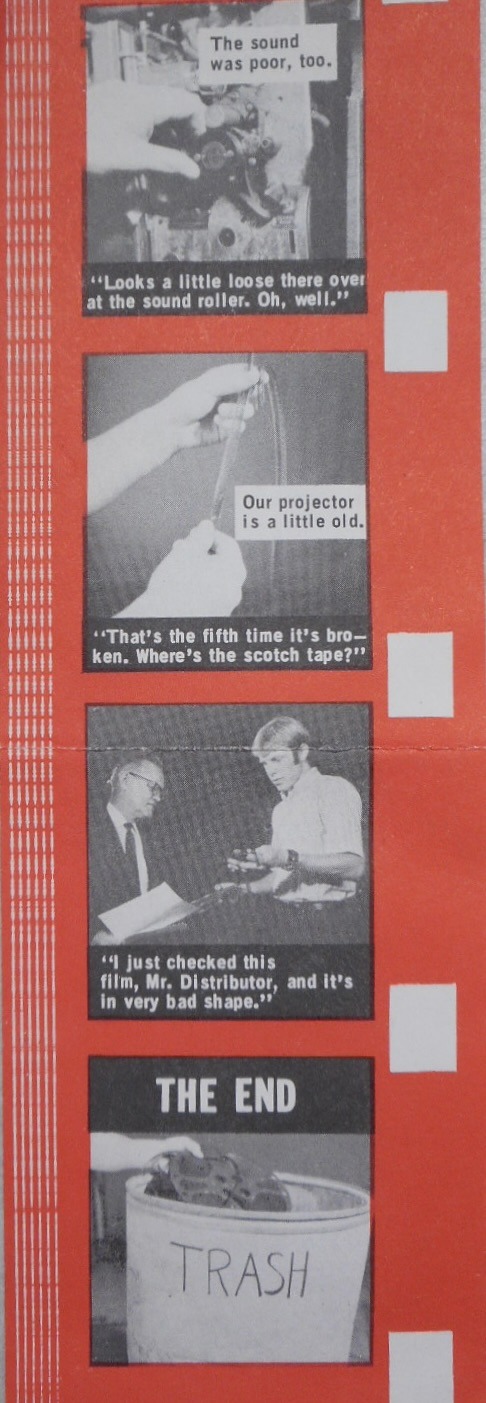


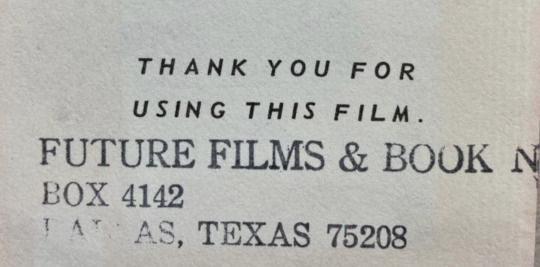
Unfortunately, these examples of how circulating films get damaged are all too true! This great advice comes on a simple little flier inside a can of film in our Protestant Radio & Television Center Collection. Ken Anderson was a religious-film producer. See his Wikipedia entry: https://en.wikipedia.org/wiki/Ken_Anderson_(filmmaker)
18 notes
·
View notes
Photo


The
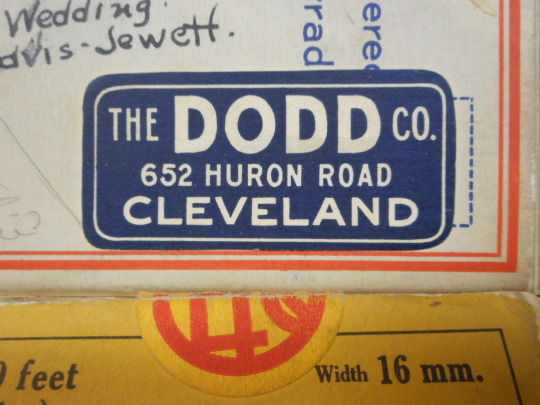
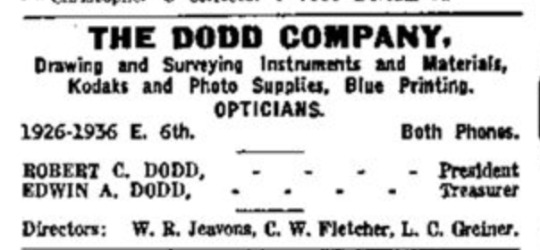
A collection of home movies came in recently that had some great shop stickers on them. Obviously, these films were processed in Cleveland. The Dodd Company had a lot of irons in the fire: surveying instruments, drawing materials, Kodak supplies, and they were OPTICIANS! [We’ve actually seen an optician+camera shop label before, on our 28mm home movies.]
The Dodd Company has been around since 1891! And it is still in business with locations in Cleveland, Chicago, Cincinnati, Dayton, and Columbus.
10 notes
·
View notes
Photo


Here are a couple of examples of items for which one can do a little bit of online searching to flesh out your understanding of your holdings. The first image is of an embossed 16mm steel film can lid. It’s actually a flipped image of the underside of the can because the top is covered in old tape that won’t come off. Embossed cans often had the name of a camera shop on them and a city. In this case, no city, no camera shop, but someone’s name and the intriguing “sports films.” The can holds a high school football game from the 1960s. Makes sense. So I wondered about Bob Friedman and figured maybe he worked in Atlanta. That’s a common name, but I didn’t find him in Georgia, I found him in Clarksdale, MS, in the census and with his wife there in a business incorporation record. But then not much else, until I found a grandson’s posting about his having headed the film dept of the Dallas Cowboys, and then I found other records that confirmed it, and he’s buried in Dallas. Okay, that’s our man. But did he have anything to do with the HS football games shot in NW Georgia? I don’t think so. I suspect he sold sports films through the mail and some coach in the Rome, GA, area bought one and then the can was re-used to house that HS team’s footage we have today.
In the second case....I’m stumped! I can’t yet find a record of this film lab in south Georgia, or even a route 3 in Nashville, GA. It’s interesting to note, though, that there was a film lab down south, and they may have had some business from north Florida cities like Tallahassee and Jacksonville.

4 notes
·
View notes
Photo

Great graphics on the address label for C&C Films, Inc., then at 400 Park Avenue, NYC.
14 notes
·
View notes
Photo


This looks like a homemade “china girl” color checking shot. Found amidst outtakes for a film made by the Protestant Radio & Television Center in May 1963.
5 notes
·
View notes
Photo

We’re going through a collection from the 1950s and are seeing some interesting old lab bags. This one is paper. So much better than plastic.
3 notes
·
View notes
Photo




Just a few nice film company logos to brighten your Monday.
1 note
·
View note
Photo


Took a photo of the Beeland-King label because it is a great looking logo, then went looking through the newspapers for more info on them. Glad to see they supported the Amateur Movie Makers of Atlanta! Article is from April 21, 1953.
Charles D. Beeland and Richard W. King were the company’s founders.
2 notes
·
View notes
Text
The best worst Tenite reel I’ve ever seen!
Wow, I know that Tenite plastics degrade over time, as I’ve mentioned often in this blog, but this one really takes the cake.

You can’t really tell, but this is a grey reel (originally) that is now fully coated with the exudation of Tenite breaking down. THIS REEL IS ACTUALLY FUZZY! Soft and fuzzy plastic! Zowie!

It is a thick coating of blech, all around the reel. And here’s what it left behind on the film it was stacked on top of:

This collection of vinegaring films is mostly not something we will be able to keep. There are a few items in it that are in good enough condition to save, but fuzzy Tenite reels will not be coming into the archives.
7 notes
·
View notes
Text
Compiling Telenews Clips
Okay, so I’ve been slaving over a bench in the last couple of weeks, relentlessly splicing tiny spools of 60-year-old Telenews clips together so we can scan them. Here are a couple of “before” shots of what’s in each can:
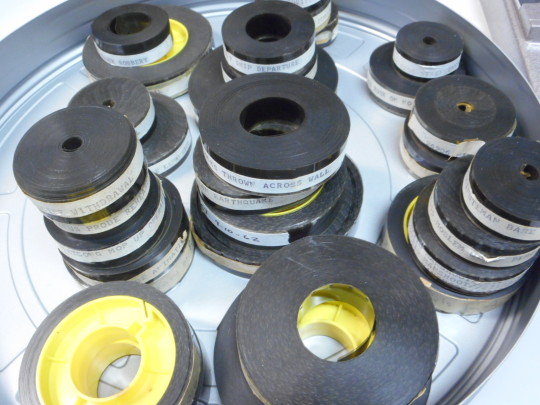
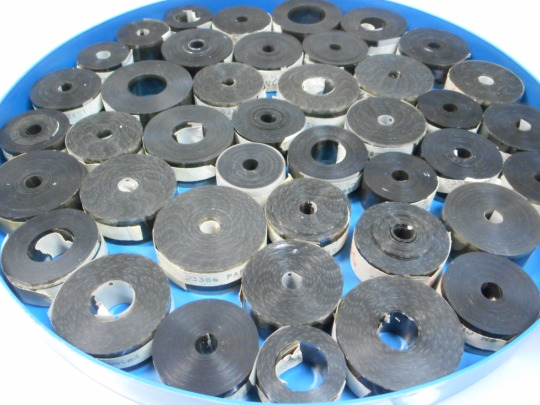
Each of those little spools of film is tighly wound and sealed with masking tape. Old tape residue has to be cleaned off, leader inserted between clips, and notations about the clips made on the leader. The really tight spools end up with a very, very strong curl to them, which sometimes pops away from the splicer and becomes a curly, bouncy, wild piece of film spiraling around the split reel. Highly annoying after it happens a few times.
The top can image ended up being two finished compilation reels, and I just want to brag here that, purely by eyeballing how many spools I would compile and by total chance, I got both reels the same size. That never happens, and I am stupidly pleased by the result.
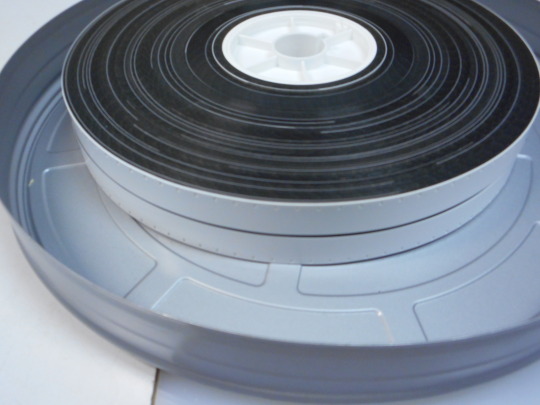
4 notes
·
View notes
Photo






The life cycle of a audiovisual materials request as seen by your friendly university film library. Graphics from the 1954 Teacher Education: A Selected List of Resource Materials, Extension Service, The University of Texas.

6 notes
·
View notes
Photo


Today we received a washcloth as part of the packing material in a box of videotapes. It’s the perfect accompaniment to the bar of Lava soap that came in a news film can a few years ago.
2 notes
·
View notes
Photo

We had a fun time this week trying to figure out where these Spanish-style pavilions in the background of this home movie were shot. The film is of some waterskiing performances on a lake, but what lake?
Watch the film here, starting at 1:14 in: https://bmac.libs.uga.edu/index.php/Detail/objects/463877
The locale didn’t look like Cypress Gardens in Florida, but the performances did. I got in touch with an archivist at the Florida Memory Project, thinking that the Spanish style meant “Florida” (so many of them do), but he couldn’t figure it out, either. The location was all wrong.
Using the power of our own librarians, we got an answer! Those are the pavilions at Lakewood Park, once the home of the Southeastern Fair in south Atlanta, near the airport! Lakewood Park was also the home of the Greyhound wooden roller coaster that shows up in the Smokey & The Bandit films and was destroyed in one of them. There was also a raceway at Lakewood: https://georgiaracinghistory.com/lost-tracks/lakewood-speedway/ and Arthur Montgomery, who shot this home movie, was instrumental in bringing auto racing and other sports to the Atlanta area. Lakewood is now home to a film studio: https://www.youtube.com/watch?v=BApF90pM9pY
Even better, the librarian found an article about the waterskiers and they are actually the performers from Cypress Gardens performing in Georgia, including two world champion skiers.
See? You just never know what’s going to show up in home movies.

3 notes
·
View notes
Photo
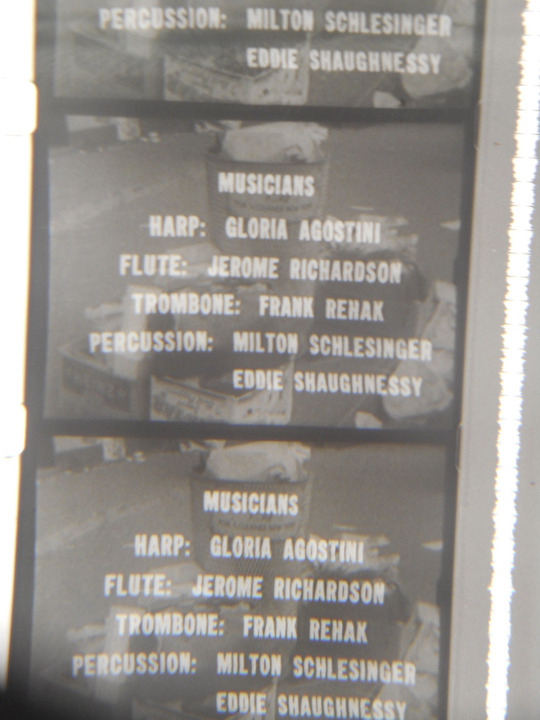
How many of you remember Ed Shaughnessy when he was the drummer on THE TONIGHT SHOW in the Johnny Carson days? Such as in this clip of him with Buddy Rich: https://www.youtube.com/watch?v=1QXdi25469U
These frames are from the tail credits of a 1961 WCBS-TV production called JUNKYARD BY THE SEA about drug addiction in New York. See the NYT review at https://timesmachine.nytimes.com/timesmachine/1961/01/13/118012391.html?pageNumber=59
You never know what’s going to crop up in the films we preserve.
1 note
·
View note